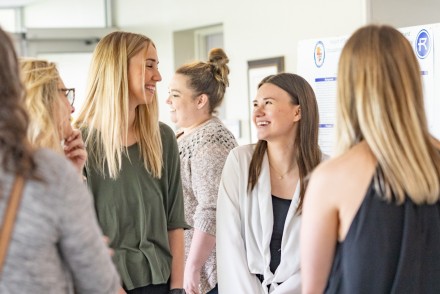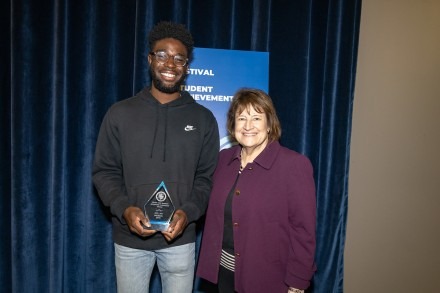The Festival of Student Achievement (FOSA) celebrates students, staff and faculty who exemplify academic excellence and leadership. FOSA festivities traditionally begin with an opening & awards ceremony in Arrupe Auditorium, followed by poster and platform (oral) presentations – including the Rockhurst Outstanding Research Award (RORA) presentations at various locations in Arrupe Hall. Visual and preforming art sessions are also part of the celebration. Campus members and guests are invited to attend all events during FOSA.


Awards presented at the opening FOSA ceremony, as well as information on presenting student work at FOSA, are noted below.
Academic Awards
Colleges, divisions, and departments are invited to have their student awards presented during the FOSA opening ceremony. Historically, undergraduate awards that are displayed in the commencement program are included. Physical awards will also be presented during the ceremony and should be provided by the respective college, division, or department prior to FOSA.
Student Development and Leadership Awards
Awards are presented annually to individual students, student organizations, faculty, and staff at FOSA. These awards and their descriptions are listed below:
Outstanding Community Service Award
The Outstanding Community Service Award is presented to one student or student organization that has shown continued commitment to the campus and/or the surrounding community.
Living Like Sam Service Award
This award will be presented to one student who has shown a commitment to being a man or woman for and with others by giving of their time to community partners in the Kansas City area. This could include agencies with partnerships to Rockhurst or an agency that the student took the initiative to find and connect with through one of their passion areas.
This award is named after Sam Zech, a student in the Research College of Nursing, a cheerleader, a member of Gamma Phi Beta, an advocate for the underprivileged, and a Girls on the Run Coach. Sam passed away in May of 2021 after a short but mighty battle with Stage 4 Appendix Cancer. Sam was a woman for others through her actions, accepting everyone she encountered, and we honor her by naming this service award after her and the life she lived. Sam’s passion for others and the community can continue to shine through every recipient of this award.
Outstanding Student Organization Award
The Outstanding Student Organization Award is presented to a student group that has shown exemplary leadership in the areas of student programming, service, community outreach, the improvement of the quality of life on campus, and a commitment to the Rockhurst mission.
Rising Star Award
The Rising Star Award is presented to one student or organization that has grown and improved above and beyond expectations, transforming the Rockhurst community in a positive way as a result.
Living the Mission Living the Mission Emerging Student Leader Award
The Living the Mission Emerging Student Leader Award is presented to two students (first year or second year) who have shown extraordinary leadership throughout the past year through their academics, involvement in student organizations, service, and commitment to the Rockhurst mission.
Living the Mission Advanced Student Leaders Award
The Living the Mission Advanced Student Leader Award is given to two students (upperclassmen) who have shown extraordinary leadership throughout their time at Rockhurst through their academics, involvement with student organizations, service, and commitment to the Rockhurst mission.
Outstanding Student Leader
The Outstanding Student Leader Award annually recognizes students who have gone above and beyond in their service to organizations on campus during their time here.
Hawk of the Year
This award recognizes a senior who has proven to be a pillar in this community and exemplifies the qualities of learning, leadership and service in the Jesuit tradition. This individual leads by example, is compassionate and warm-hearted, puts 100% into everything they do, makes a difference every day, and has earned the respect of all fellow students at Rockhurst. This is an opportunity for students to recognize one another based on the characteristics that make an individual stand out as a human being. This senior not only represents the best that Rockhurst offers but also makes every day on campus a brighter one simply by being present.
Faculty and Staff Members of the Year
Each year, the Student Senate gives the Student Body an opportunity to select a faculty and staff member of the year through an online voting process.
Undergraduate Research Mentor of the Year
Students who submitted presentations for inclusion in this year’s FOSA and RORS events have the opportunity to nominate their faculty mentor(s) for this award. Nominations are reviewed by the Student Research Scholarship, and Creativities Committee, and one recipient is selected based on the strength of the student nominations.
We encourage members of the Rockhurst community to nominate deserving persons and groups for awards. Online nomination forms for all awards can be accessed via RockSpace by all faculty, staff, and full-time undergraduate students. The form link, as well as instructions, are listed below. If you have challenges accessing the form, please reach out to Emma Rapp, Director of Student Life.
Academic Sessions
Rockhurst Outstanding Research Award (RORA) Presentation
RORA was created in 2010 as a forum for students of all disciplines to present outstanding work in research. Under faculty nomination, the RORA speaker is selected by the Student Research Scholarship and Creative Activities Committee. The chosen talks reflect the wide-ranging representation and excellence of student research at Rockhurst.
General Presentation Sessions
Students are encouraged to submit research abstract if interested in presenting the following types of work at FOSA:
Oral Presentations
Students are invited to present scientific projects, results of undergraduate research, and original academic papers during this session. The sessions are 15 minutes long, with an extra 5 minutes assigned to questions.
Interactive Demonstrations
Students are invited to create fifteen-minute presentations in which they provide brief demonstrations and explanations of their work and/or present their creative projects.
Poster Sessions
Students stand by their posters displaying presentations of creative work, scientific projects, or other forms of academic research. Students have the opportunity to engage passersby in discussions related to their work. Standard poster size is 3 feet by 4 feet, though special large formats may be accommodated if needed. Please specify in the submission form if your poster is oversized.
Art Sessions
FOSA features a visual art exhibition, performance of music, theatrical monologues, and poetry readings from students engaged in a variety of disciplines. Students interested in showcasing their work should contact their art/literature instructors directly.
